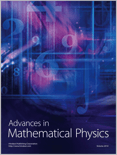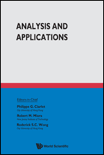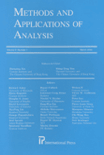
Networks and Heterogeneous Media
Scope & Guideline
Bridging Disciplines through Cutting-edge Research
Introduction
Aims and Scopes
- Mathematical Modeling of Complex Systems:
The journal focuses on developing mathematical frameworks for various complex systems, including traffic flow, epidemic dynamics, and network interactions. This includes both deterministic and stochastic modeling approaches. - Numerical Analysis and Computational Methods:
A significant emphasis is placed on numerical techniques for solving partial differential equations (PDEs), integro-differential equations, and other mathematical models. This includes innovative methods like finite element methods, spectral methods, and hybrid approaches. - Interdisciplinary Applications:
Research published in the journal often applies mathematical theories to real-world problems across different domains, such as epidemiology, environmental science, and engineering, highlighting its interdisciplinary nature. - Stability and Control of Dynamical Systems:
The journal explores stability analysis, control strategies, and optimization methods for various dynamical systems, particularly in the context of networked systems and fluid dynamics. - Emerging Technologies and Theoretical Advances:
It also showcases research on emerging technologies, such as machine learning and neural networks, in the context of mathematical modeling and analysis.
Trending and Emerging
- Epidemic Modeling with Complex Dynamics:
There is a growing emphasis on modeling disease dynamics that incorporate factors such as variable susceptibility, hybrid models, and the effects of public health interventions, particularly in the context of recent global health challenges. - Machine Learning and Data-Driven Approaches:
An increasing number of studies are leveraging machine learning techniques for predictive modeling and data analysis, particularly in applications related to traffic flow, epidemic dynamics, and network optimization. - Fractional Calculus and Nonlocal Models:
Research utilizing fractional calculus to model memory effects and nonlocal interactions in various systems is on the rise, reflecting a trend towards more sophisticated mathematical tools. - Stochastic and Uncertainty Quantification Methods:
There is a notable increase in papers addressing uncertainty quantification and stochastic methods, particularly in modeling complex systems affected by randomness and variability. - Network Theory and Graph-Based Approaches:
The application of network theory to understand complex interactions within various systems, such as social networks and biological systems, is becoming increasingly prevalent.
Declining or Waning
- Traditional Traffic Flow Models:
There has been a noticeable decrease in papers focusing on classic traffic models that do not incorporate modern complexities or technologies, such as adaptive traffic control systems or connected vehicle dynamics. - Basic Epidemic Models Without Complex Interactions:
Research centered around simple compartmental models (e.g., SIR) without considering heterogeneous populations, time delays, or network interactions appears to be waning as more sophisticated models gain traction. - Static Mathematical Theories:
The journal seems to be moving away from purely theoretical papers that lack practical applications or numerical validation, as the trend shifts towards applied research that demonstrates real-world relevance. - Conventional Numerical Techniques Without Innovation:
There is a decreasing trend in the publication of papers that present conventional numerical methods without significant advancements or novel applications.
Similar Journals

Annals of the University of Craiova-Mathematics and Computer Science Series
Unlocking Potential: Bridging Mathematics and Computer ScienceAnnals of the University of Craiova-Mathematics and Computer Science Series, published by UNIV CRAIOVA, is a distinguished academic journal that serves as a platform for advancing knowledge in the fields of mathematics and computer science. With an ISSN of 1223-6934 and an E-ISSN of 2246-9958, the journal has been disseminating high-quality research since its inception in 2011 and is targeted toward researchers, professionals, and students from these dynamic fields. It has been recognized in the Q3 category for both Computer Science Applications and Mathematics (miscellaneous) as of 2023, highlighting its emerging influence in the academic community, despite its current Scopus Rankings placing it at 42nd percentile for Mathematics and 14th percentile for Computer Science Applications. The journal's commitment to open access and its ongoing contributions until 2024 position it as a vital resource for fostering collaboration and innovation in Romania and beyond. Researchers interested in mathematics and computer science will find valuable insights and cutting-edge studies within its pages.

Frontiers of Mathematics
Innovating Research to Shape the Future of MathematicsFrontiers of Mathematics, published by SPRINGER HEIDELBERG, is an emerging academic journal dedicated to fostering the advancement of mathematical sciences from 2023 to 2024. With an ISSN of 2731-8648 and E-ISSN of 2731-8656, this journal is positioned in the category of Q2 in the miscellaneous mathematics domain, showcasing its commitment to quality research and innovation. Although in its nascent stages, it has swiftly established a foothold within the global academic landscape, holding a Scopus rank of #198/399 and a median percentile of 50, indicating a promising trajectory. By providing an open-access option, Frontiers of Mathematics ensures broad dissemination of research findings, fostering collaboration and knowledge sharing across the mathematical community. Researchers, professionals, and students alike will find this journal to be an invaluable resource, contributing to important discussions and advancements in various mathematical fields.

Advances in Mathematical Physics
Connecting Scholars through Pioneering ResearchAdvances in Mathematical Physics is a premier open-access journal published by HINDAWI LTD, dedicated to the dissemination of research in the fields of applied mathematics and physics. With its ISSN 1687-9120 and E-ISSN 1687-9139, this journal has been a vital platform for innovative studies since its inception in 2009, fostering a collaborative environment for researchers and professionals alike. The journal features a wide range of topics, including but not limited to mathematical models, computational physics, and interdisciplinary applications, thus attracting a diverse readership. Ranked in the Q3 quartile for both Applied Mathematics and Physics and Astronomy, it serves as a significant resource for academics looking to explore cutting-edge developments and theoretical advancements. With an emphasis on open accessibility, Advances in Mathematical Physics ensures that research findings are readily available to the global academic community, leveling the playing field for emerging scholars and seasoned researchers. By consistently showcasing high-quality manuscripts, the journal contributes substantially to the fields of mathematics and physics, encouraging scholarly dialogue and advancing knowledge across a myriad of applications.

Analysis and Applications
Bridging Theory and Application for Mathematical InnovationAnalysis and Applications is a prestigious academic journal dedicated to the interdisciplinary exploration of analysis and applied mathematics. Published by WORLD SCIENTIFIC PUBL CO PTE LTD and based in Singapore, this journal serves as a vital resource for researchers, professionals, and students engaged in mathematical investigations that extend theoretical concepts into practical applications. With an impressive Impact Factor reflective of its esteemed reputation, it currently ranks in Q1 across both Analysis and Applied Mathematics categories, showcasing its relevance in advancing knowledge within these fields. The journal's commitment to high-quality scholarly articles is underlined by its excellent performance in Scopus rankings, placing it in the top percentiles of mathematics disciplines. Analysis and Applications invites contributions that not only deepen theoretical frameworks but also translate findings into applicable methodologies, ultimately fostering innovation and progress in mathematical sciences. For those seeking a gateway into cutting-edge research and developments, this journal is a crucial platform to engage with the latest insights and collaborative opportunities.

COMMUNICATIONS ON PURE AND APPLIED ANALYSIS
Where Rigorous Research Meets Practical ApplicationCOMMUNICATIONS ON PURE AND APPLIED ANALYSIS, published by the American Institute of Mathematical Sciences (AIMS), is a pivotal journal that serves the fields of pure and applied mathematics. With an ISSN of 1534-0392 and an E-ISSN of 1553-5258, this journal showcases rigorous research findings that span a myriad of topics within mathematical analysis and its applications. Given its impressive Q2 ranking in both Analysis and Applied Mathematics categories, it is recognized for its significant contributions, ranking 92nd out of 193 in Analysis and 369th out of 635 in Applied Mathematics according to Scopus. The journal, running continuously from 2004 to 2024, invites submissions that push the boundaries of mathematical thought and practice. While it operates under a traditional access model, the journal's comprehensive scope and burgeoning impact factor underscore its importance for researchers, professionals, and students who seek to engage deeply with current mathematical advancements.

Methods and Applications of Analysis
Bridging Theory and Practice in AnalysisMethods and Applications of Analysis is a distinguished academic journal published by INT PRESS BOSTON, INC, focusing on the intersection of mathematical methodologies and their diverse applications across various scientific disciplines. With an ISSN of 1073-2772 and an E-ISSN of 1945-0001, this journal aims to provide a robust platform for researchers and professionals to share groundbreaking findings and innovative approaches in analytical methods. Despite the absence of an Open Access model, the journal is committed to enhancing the visibility and accessibility of high-quality research. The scope of Methods and Applications of Analysis encompasses both theoretical advancements and practical implementations, making it a vital resource for those seeking to deepen their understanding and expertise in analytical techniques. With its presence in the academic landscape, this journal is key for students and professionals striving to stay at the forefront of analysis methodologies.

JOURNAL OF COMPUTATIONAL MATHEMATICS
Connecting Practitioners and Theorists in Mathematical InnovationJOURNAL OF COMPUTATIONAL MATHEMATICS, published by GLOBAL SCIENCE PRESS, is a distinguished peer-reviewed academic journal dedicated to advancing the field of computational mathematics. With a focus on high-quality research that bridges theoretical and practical applications, this journal aims to disseminate innovative methodologies and robust algorithms that address complex mathematical problems. Operating without an open-access model, it maintains a reputable standing with a Q2 category classification in computational mathematics as of 2023, showcasing its influence and relevance within the academic community. The journal, which has been in publication since 1996, continues to evolve, providing a platform for researchers, practitioners, and students to engage with cutting-edge developments up to 2024. By contributing to the body of knowledge in computational mathematics, this journal plays a vital role in fostering collaboration and advancement in related disciplines.

Journal of Systems Science & Complexity
Illuminating the Dynamics of Complexity in Technology and Beyond.The Journal of Systems Science & Complexity, published by SPRINGER HEIDELBERG, stands as a leading forum for innovative research in the fields of computer science and information systems. With an ISSN of 1009-6124 and an E-ISSN of 1559-7067, this journal has established itself within the academic community, garnering a commendable impact factor that reflects its influential contributions. Operating from 2006 and continuing through 2024, it is categorized in the Q2 quartile for both Computer Science (Miscellaneous) and Information Systems, indicating its quality and relevance. Recognized within Scopus rankings, it places 52nd out of 133 in its specific field, affirming its significance in advancing systems science discussions. Researchers and professionals will find a wealth of knowledge through rigorous peer-reviewed articles that explore complex systems and their applications, enabling readers to stay at the forefront of technological advancements and interdisciplinary collaboration.

Computational Methods for Differential Equations
Exploring Innovative Solutions in Differential EquationsComputational Methods for Differential Equations is a prominent academic journal dedicated to the exploration and application of computational techniques in the realm of differential equations. Published by UNIV TABRIZ, this open-access journal has been providing unrestricted access to groundbreaking research since 2013, making it a valuable resource for the global academic community, particularly in Iran. It has carved out a niche within the fields of Algebra and Number Theory, Applied Mathematics, and Numerical Analysis, maintaining a Q3 quartile ranking in 2023 across these categories. Researchers, professionals, and students alike will find the journal's commitment to disseminating innovative computational methodologies essential for advancing knowledge and developing robust solutions to complex mathematical problems. With its ISSN 2345-3982 and E-ISSN 2383-2533, the journal ensures wide visibility and accessibility, serving a diverse audience and promoting scholarly discourse.

NUMERICAL ALGORITHMS
Empowering mathematical breakthroughs through algorithms.NUMERICAL ALGORITHMS, published by Springer, is a leading journal in the field of Applied Mathematics, distinguished by its relevant research publications since 1991. With an ISSN of 1017-1398 and E-ISSN 1572-9265, this journal ranks in the Q2 category of Scopus for Applied Mathematics, placing it in the top 22% of its field based on the latest 2023 rankings. The journal strives to disseminate innovative algorithms and methodologies that impact both theoretical developments and practical applications. Although currently not an open-access journal, it offers widespread access through institutional subscriptions, making it an essential resource for researchers, practitioners, and students committed to advancing numerical techniques and their applications in complex problem-solving scenarios. Located in Dordrecht, Netherlands, NUMERICAL ALGORITHMS aims to foster collaboration and knowledge exchange among the global mathematical community, providing a pivotal platform for high-quality research and critical discourse.